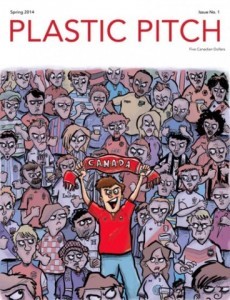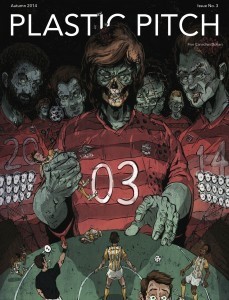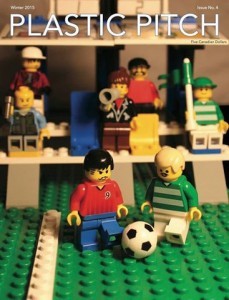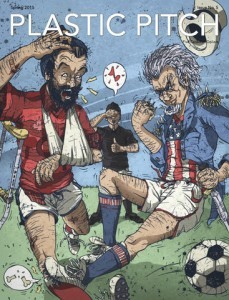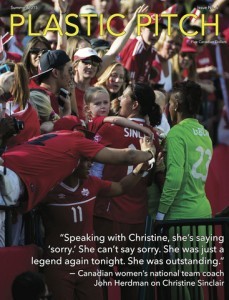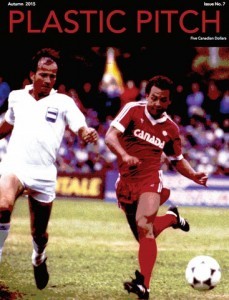Steven Sandor's Blog, page 83
December 15, 2015
The Fury’s new boss: The Paul Dalglish Q and A
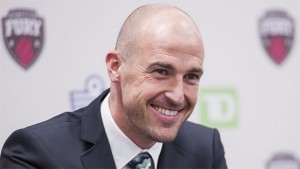 In the magazine world, try as we might to keep a lid on the things we’re working on, we’re often foiled by the daily news cycle. Today is one of those days. I interviewed new Ottawa Fury head coach Paul Dalglish a couple of weeks ago; the interview was set for the next issue (No. 8) of Plastic Pitch. But, wow, have things changed. Phillip Dos Santos in now the technical director of the Fort Lauderdale Strikers. Ryan Richter, Sinisa Ubiparipovic and Richie Ryan have all had their transfer requests approved. And the team has already lost forwards Tommy Heinemann and Andrew Wiedeman. There’s been a bloodletting in Ottawa, and it simply can’t be ignored. So, I’ve made the call to run the Dalglish Q and A on the website.
In the magazine world, try as we might to keep a lid on the things we’re working on, we’re often foiled by the daily news cycle. Today is one of those days. I interviewed new Ottawa Fury head coach Paul Dalglish a couple of weeks ago; the interview was set for the next issue (No. 8) of Plastic Pitch. But, wow, have things changed. Phillip Dos Santos in now the technical director of the Fort Lauderdale Strikers. Ryan Richter, Sinisa Ubiparipovic and Richie Ryan have all had their transfer requests approved. And the team has already lost forwards Tommy Heinemann and Andrew Wiedeman. There’s been a bloodletting in Ottawa, and it simply can’t be ignored. So, I’ve made the call to run the Dalglish Q and A on the website.
In the interview, Dalglish also addressed the plunging Canadian dollar. He said he still owns a home in Austin, Tex. and now that he’s working in Canada, he has seen his back-home expenses soar by a factor of 1.3 because of the poor exchange rate. He said that, often, when signing American players, they will have expenses back home, from student loans to car payments to housing arrangements, that are paid in U.S. dollars. So, a weakening Canadian dollar is a factor. (more on the currency issue in issue 8 of Plastic Pitch and, of course, you’ve subscribed, haven’t you?)
PP: Did you approach the Fury, or did the Fury approach you?
PD: I don’t know exactly which way around it was. I’ve had a relationship with (team president) John Pugh for a while, since the PDL days. With Marc leaving and Austin announcing that it wouldn’t be playing next year, the timing was perfect for myself and Ottawa.
PP: If the Aztex could have found a stadium, would you have stayed in Texas?
PD: For sure, I would have stayed. I’d only just started a project there. When you’re an expansion team, the first year is not about winning. It’s about laying down a foundation for the future. It’s in year two, year three, that you start fulfilling expectations and start achieving things. I’m disappointed that the stadium situation in Austin didn’t give me that chance.
PP: Officially, the USL is the third division in North American soccer and the NASL is the second division. Do you think that the NASL standard of play is better than USL’s?
PD: No. If you look back to last year, I think every single USL team beat their NASL opponents in the U.S. Open Cup. With the Aztex, we played San Antonio and we beat them. But it is difficult to compare the leagues. USL is higher-tempo, but more of a direct game. In NASL, it’s a slower pace, there’s more patience in the play. There’s really no different in terms of level, but they are very different in terms of style.
PP: Ottawa played for the NASL championship in 2015. Do you feel the pressure of building on that standard for 2016?
PD: In lower leagues, you’re always in a constant state of flux. Every year is a rebuilding year, because of the nature of the contracts in the lower leagues. You are dealing with roster turnover that’s much larger than you’d see in MLS. So, you’re not looking to build, you’re in a constant state of rebuild. But, with the players we’ve got, with the budget we have, we’ll be able to put a top-level product on the pitch. There’s a lot of pressure on me to be successful. I don’t like to be second.
PP: You played in MLS, with the Houston Dynamo, back in 2006. You’ve been on coaching staffs in MLS, at FC Tampa Bay, and in USL. Now, with NASL, do you see your job as needing to keep the team to
ever-rising standards of the league?
PD: It’s a tough one, it’s like comparing Jack Nicklaus to Tiger Woods. It’s difficult to compare teams from different generations and leagues from different years. The game continues to change, so some years will be better than
others. What I can say is that the growth of football has been phenomenal in the last 10 years. When I came to North America, there was only 12 teams in MLS at that time and the only other league we had was USL. Now we have USL, NASL and MLS is over 20 teams. I think, with all of the expansion, the players may be diluted a bit, and so the standard of play might be diluted a bit. There are only so many American players to go around, and (in NASL), you can only have seven international players.
PP: You spoke of American players, but do you plan to keep looking to add Canadian players to the team, as well?
PD: For sure. We need good Canadian players, we need good American players. We need as many of them as we can get, because you’re only allowed seven international player, good domestic players are a necessity. So, we will give Canadian players a chance. As well, it’s part of the mission of the club — to provide opportunities to Canadian players. It was made very clear to me when I took this job. In fact, there are a couple of Canadian players who aren’t with the club that we’re tracking right now.
SUPPORT OUR DRIVE FOR 500! SUPPORT CANADIAN SOCCER JOURNALISM! SUBSCRIBE TO PLASTIC PITCH TODAY!
The 500 club: The Plastic Pitch subscription drive
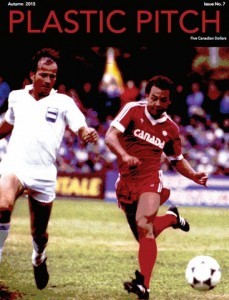 When the Plastic Pitch Kickstarter campaign was launched in late 2013, the goal was to secure funding for at least a year’s worth of issues. Now, based on our quarterly schedule, we are working on issue 8, to be releasd in January 2016. That’s two full years worth of work. We’ve featured work from some of the top soccer writers in North America, and featured stories about Canadians playing here and abroad.
When the Plastic Pitch Kickstarter campaign was launched in late 2013, the goal was to secure funding for at least a year’s worth of issues. Now, based on our quarterly schedule, we are working on issue 8, to be releasd in January 2016. That’s two full years worth of work. We’ve featured work from some of the top soccer writers in North America, and featured stories about Canadians playing here and abroad.
But, it isn’t easy. And expenses continue to pile up. I’ve crunched the numbers and it’s simple. To make this work, Plastic Pitch needs 500 new subscribers by the end of the year. Well, maybe “new” isn’t quite accurate — as renewals would be counted towards to this number.
Subscriptions costs just $15 Canadian — that’s four issues of what this editors feels is some of the best Canadian soccer content you’ll find. Long-form stories, insightful analysis and advocacy for the improvement of the Canadian game. Put it in perspective, $15 is less than the cost of one craft cocktail.
There are a number ways to subscribe; either through the Apple or Google apps, through our Shopify store (CLICK HERE) or directly via PayPal (teamworkpress@rogers.com is the payment address). If you subscribe through Shopify or PayPal, please specify if you want to have issues e-mailed directly to you. But, one word of caution: It is MUCH easier for us to refund your money (if we don’t hit target) if you go through Shopify or PayPal.
Of course, we think a subscription to Plastic Pitch would make a great Christmas gift. Or a way to say thanks to your coach or the volunteers in your soccer program.
Because we put the mag out in three ways; either by e-mail, or through Apple and Google apps, many of our expenses have to be paid out in US funds, even though we’re a Canadian mag. So, the plummeting dollar, well, it hurts. Really hurts. Basically, costs to do business have increased 25 per cent over the past two years.
If you haven’t discovered the mag yet, and want to read it before you buy, you can preview any of our seven issues for free in the apps. Each issue offers a free timed preview, which lets you browse the articles. Inside you’ll find how we were the first to report about the possibility of a Canadian Division 1A league (issue 2), our look at how real Canadian minutes played were on the decline in MLS (issue 1), plus our issue 5 dedicated to the fractured soccer relationship between Canada and the United States. Issue 6 was our Women’s World Cup review issue.
As well, from now till Christmas, you will be able to get our back issues (1-6) for just $1.99 each. You can take advantage of those offers through the apps.
PLASTIC PITCH SUBSCRIPTION DRIVE:
445 to go!
December 14, 2015
Maybe, just maybe, Christine Sinclair has an heir out there

Christine Sinclair
To promote women’s soccer in Canada, Christine Sinclair is the go-to spokesperson, the poster child for the game in this country.
But, if there’s a positive to come out of the first two games of the Natal Tournament in Brazil, it’s that we may, finally, have other scoring options to talk about. Sure, Sinclair scoring three times over the course of wins over Mexico and Trinidad and Tobago got the headlines. She’s moved into second all-time on the women’s international football scoring charts. But, for too long, Canada has had little to offer in terms of secondary scoring. And, as Sinclair ages, we can’t just worry about who is going to support her; we need to find out if there’s actually an heir apparent out there.
And that’s why, two-thirds through the tourney, Canadian national women’s team coach John Herdman is enthused by what he’s seen from the younger players he’s brought into the fold. Janine Beckie, the NCAA scoring terror who was left off the World Cup squad, has scored. Nichelle Prince has bagged a couple. Teenager Marie Levasseur has been an offensive catalyst.
Herdman said the goal for Natal was “to bring in new faces, to give them opportunities while maintaining that mindset — winning football matches. I think the team has stayed on course for that. We’ve been able to give debuts to very young players. Everyone’s either had a start or come into a game.
“We’ve seen new faces scoring goals and consistent faces scoring goals. The chemistry’s starting to build, it’s not perfect for sure, but there’s been some flashes that certainly got us excited internally as a team and we can definitely see there’s more to come.”
At the Women’s World Cup, no other scoring options than Sinclair appeared, and even Herdman allowed after the tournament that the Canadian attack was “predictable.” Before Natal, he said the young ”mavericks” being brought into the fold would add more spontaneity to the side.
So, to see other names on the scoresheet — and not just one or two goals over the course of a tournament either — is actually more exciting than seeing Sinclair pull into second place on that all-time scoring list.
SUPPORT OUR DRIVE FOR 500! SUPPORT CANADIAN SOCCER JOURNALISM! SUBSCRIBE TO PLASTIC PITCH TODAY!
The CONCACAF Women’s U-20 final: A friendly disguised as a championship
 Daniel Worthington, the coach of the Canadian U-20 women’s team, treated Sunday’s CONCACAF final like a glorified friendly.
Daniel Worthington, the coach of the Canadian U-20 women’s team, treated Sunday’s CONCACAF final like a glorified friendly.
He used two 15-year-olds and three 16-year-olds in the 1-0 loss to the United States. Lysianne Proulx, born in 1999, got the start in goal, and it was her second-half errant pass that led to the Americans’ winning tally.
Canada’s approach to a regional final illustrated the big problem when it comes to youth tournaments that act as qualifiers for their respective World Cups. And that is: With the finalists already qualified for the Women’s U-20 World Cup, the, ahem, championship game means very little.
The CONCACAF Women’s U-20 Championship formula is simple; three teams qualify out of the tournament — the two finalists and the winner of the third-place game.
So, when Canada beat Mexico in penalties Friday in the semis, it booked its place in Papua New Guinea. After 120 grueling minutes Friday, the team had a little less than 48 hours to be ready for a final — but with qualification already assured, the CONCACAF trophy doesn’t mean all that much. And Canada treated the final that way, using the game as a means to give the youngest players on the team experience.
But that’s going to happen when the World Cup qualifying format means that the CONCACAF semifinal is a more important game than the final.
In the post-game press conference, Worthington said that Canada’s No. 1 goal was to qualify for the Women’s U-20 World Cup, then the No. 2 goal was to develop players. Winning the CONCACAF tournament — not on that list.
“It’s about the bigger picture, it’s about the EXCEL program, it’s about the women’s national-team program and increasing the positional threshold. And you don’t do that unless you give kids a chance in big games,” Worthington said after the final.
SUPPORT OUR DRIVE FOR 500! SUPPORT CANADIAN SOCCER JOURNALISM! SUBSCRIBE TO PLASTIC PITCH TODAY!
The 500 club: The Plastic Pitch subscription drive
 When the Plastic Pitch Kickstarter campaign was launched in late 2013, the goal was to secure funding for at least a year’s worth of issues. Now, based on our quarterly schedule, we are working on issue 8, to be releasd in January 2016. That’s two full years worth of work. We’ve featured work from some of the top soccer writers in North America, and featured stories about Canadians playing here and abroad.
When the Plastic Pitch Kickstarter campaign was launched in late 2013, the goal was to secure funding for at least a year’s worth of issues. Now, based on our quarterly schedule, we are working on issue 8, to be releasd in January 2016. That’s two full years worth of work. We’ve featured work from some of the top soccer writers in North America, and featured stories about Canadians playing here and abroad.
But, it isn’t easy. And expenses continue to pile up. I’ve crunched the numbers and it’s simple. To make this work, Plastic Pitch needs 500 new subscribers by the end of the year. Well, maybe “new” isn’t quite accurate — as renewals would be counted towards to this number.
Subscriptions costs just $15 Canadian — that’s four issues of what this editors feels is some of the best Canadian soccer content you’ll find. Long-form stories, insightful analysis and advocacy for the improvement of the Canadian game. Put it in perspective, $15 is less than the cost of one craft cocktail.
There are a number ways to subscribe; either through the Apple or Google apps, through our Shopify store (CLICK HERE) or directly via PayPal (teamworkpress@rogers.com is the payment address). If you subscribe through Shopify or PayPal, please specify if you want to have issues e-mailed directly to you. But, one word of caution: It is MUCH easier for us to refund your money (if we don’t hit target) if you go through Shopify or PayPal.
Of course, we think a subscription to Plastic Pitch would make a great Christmas gift. Or a way to say thanks to your coach or the volunteers in your soccer program.
Because we put the mag out in three ways; either by e-mail, or through Apple and Google apps, many of our expenses have to be paid out in US funds, even though we’re a Canadian mag. So, the plummeting dollar, well, it hurts. Really hurts. Basically, costs to do business have increased 25 per cent over the past two years.
If you haven’t discovered the mag yet, and want to read it before you buy, you can preview any of our seven issues for free in the apps. Each issue offers a free timed preview, which lets you browse the articles. Inside you’ll find how we were the first to report about the possibility of a Canadian Division 1A league (issue 2), our look at how real Canadian minutes played were on the decline in MLS (issue 1), plus our issue 5 dedicated to the fractured soccer relationship between Canada and the United States. Issue 6 was our Women’s World Cup review issue.
As well, from now till Christmas, you will be able to get our back issues (1-6) for just $1.99 each. You can take advantage of those offers through the apps.
PLASTIC PITCH SUBSCRIPTION DRIVE:
453 to go!
December 11, 2015
Pickett’s penalty perfection: Canada qualifies for the Women’s U-20 WC
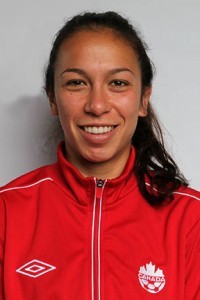
Victoria Pickett
Canada booked its spot in next year’s U-20 Women’s World Cup, but the team sure didn’t make things easy on itself.
Canada was perfect in the penalty shootout, triumphing 5-4 over Mexico in the semifinal’s of the CONCACAF Women’s U-20 Championship. As a semifinal winner, Canada booked its place in Papua New Guinea. Playing in the final is gravy.
But the teams went scoreless through 90-plus minutes of regulation soccer and 30 minutes of extra time. And, though the teams visibly tired near the end, Canada showed its backbone in the shootout. Victoria Pickett finished Canada’s five-for-five effort from the spot; even though Mexican keeper Emily Alvarado guessed correctly, Pickett’s shot was well-placed, low into the corner.
Penalties — especially in a game that has so much riding on it — are a test of mental toughness as much as they are of skill. So kudos to the Canadians for getting through it.
But, truthfully, it didn’t have to go that far. In the second half, Canadian striker Taylor Pryce twice found herself alone one-on-one with Alvarado. On the first try, the keeper made the save. On the second break, which came right before the end of regulation, Pryce rolled her attempt wide of goal.
SUPPORT OUR DRIVE FOR 500! SUPPORT CANADIAN SOCCER JOURNALISM! SUBSCRIBE TO PLASTIC PITCH TODAY!
FCE to head to Scotland; here’s why it makes perfect cents (sense)
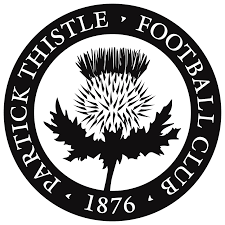
Partick Thistle is one of the clubs FCE will play on its Scottish tour.
FC Edmonton coach Colin Miller enjoyed a long and productive playing career in Scotland.
So, maybe, it’s not a big surprise that FCE announced that it will spend two weeks of its preseason training in Scotland. The team will be across the Atlantic from March 10th till the 23rd, and will play Partick Thistle, Airdrie (former club of ex-Eddie David Proctor) and Queens Park FC. They’ll also get a game in against the U-21 side of English Premier League side, Newcastle United.
Last season, the Eddies went down to the United States for three weeks ahead of the NASL opener. In a recent interview I did with owner Tom Fath for an upcoming Plastic Pitch story on the impact of the low Canadian dollar on the soccer business north of the border (look for it in issue 8), he admitted that the cost to go to America for preseason had become prohibitively expensive.
“We have held training camps in the United States, and those costs are in U.S. dollars, and we’ll have to take a look at those,” he said.
Now, that’s not to suggest a trip across the ocean is cheaper than a trip to the United States. A preseason trip to Europe in no way suggests that Fath is doing anything more but increasing his investment in a team he and his brother, Dave Fath, have lost money on since day one. But, with the dollar slumping to less than 73 cents US on Friday, and it likely to drop even further as the oil price continues to sag, the fact remains that a trip to America has become increasingly expensive, and will likely be even more pricey in the spring of 2016.
As of Friday, one Canadian dollar is worth just more than 0.66 Euros. One Canadian dollar is worth just a little less than 73 cents. At this time last year, the Canadian dollar was worth 0.69 Euros, and 87 cents US. So, the loonie hasn’t moved much against the Euro, while it’s slid badly against the US buck. So, financially speaking, a trip to Scotland vs. a trip to the United States makes a lot more sense in 2016 than it did a year ago.
“We’re a well-established, strong thought of NASL club and we now have an opportunity to put the FC Edmonton brand a wee bit more out there,” Miller said in a release. “With my connections in Scotland, we will be speaking to other clubs that have an interest in maybe working together in the future, who knows? These are the possibilities that can happen…It’s a real opportunity for us to put the club in the shop window.”
Remember that the Eddies played two games in what was the oil-rich city of Fort McMurray in 2015 (Fort McMurray is now being hit hard by the oil slump). The idea was to make the big petro players in the oil-rich north more aware of the club. Putting the club in the “shop window” was more important than the overall gate, which in each game hit just over 1,000 fans.
FC Edmonton will spend the two weeks in Stirling, Scotland.
“FC Edmonton’s preseason trip is yet another example of the NASL taking a global approach toward growing the league and improving the level of play on the field,” NASL Commissioner Bill Peterson said in the release issue by the club. “Not only will the trip give the club some great exposure, it will perhaps most importantly help them get better as a team and prepare them for what will be a very competitive 2016 season.”
SUPPORT OUR DRIVE FOR 500! SUPPORT CANADIAN SOCCER JOURNALISM! SUBSCRIBE TO PLASTIC PITCH TODAY!
December 8, 2015
The 500 club: The Plastic Pitch subscription drive
 When the Plastic Pitch Kickstarter campaign was launched in late 2013, the goal was to secure funding for at least a year’s worth of issues. Now, based on our quarterly schedule, we are working on issue 8, to be releasd in January 2016. That’s two full years worth of work. We’ve featured work from some of the top soccer writers in North America, and featured stories about Canadians playing here and abroad.
When the Plastic Pitch Kickstarter campaign was launched in late 2013, the goal was to secure funding for at least a year’s worth of issues. Now, based on our quarterly schedule, we are working on issue 8, to be releasd in January 2016. That’s two full years worth of work. We’ve featured work from some of the top soccer writers in North America, and featured stories about Canadians playing here and abroad.
But, it isn’t easy. And expenses continue to pile up. I’ve crunched the numbers and it’s simple. To make this work, Plastic Pitch needs 500 new subscribers by the end of the year. Well, maybe “new” isn’t quite accurate — as renewals would be counted towards to this number.
Subscriptions costs just $15 Canadian — that’s four issues of what this editors feels is some of the best Canadian soccer content you’ll find. Long-form stories, insightful analysis and advocacy for the improvement of the Canadian game. Put it in perspective, $15 is less than the cost of one craft cocktail.
There are a number ways to subscribe; either through the Apple or Google apps, through our Shopify store (CLICK HERE) or directly via PayPal (teamworkpress@rogers.com is the payment address). If you subscribe through Shopify or PayPal, please specify if you want to have issues e-mailed directly to you. But, one word of caution: It is MUCH easier for us to refund your money (if we don’t hit target) if you go through Shopify or PayPal.
Of course, we think a subscription to Plastic Pitch would make a great Christmas gift. Or a way to say thanks to your coach or the volunteers in your soccer program.
Because we put the mag out in three ways; either by e-mail, or through Apple and Google apps, many of our expenses have to be paid out in US funds, even though we’re a Canadian mag. So, the plummeting dollar, well, it hurts. Really hurts. Basically, costs to do business have increased 25 per cent over the past two years.
If you haven’t discovered the mag yet, and want to read it before you buy, you can preview any of our seven issues for free in the apps. Each issue offers a free timed preview, which lets you browse the articles. Inside you’ll find how we were the first to report about the possibility of a Canadian Division 1A league (issue 2), our look at how real Canadian minutes played were on the decline in MLS (issue 1), plus our issue 5 dedicated to the fractured soccer relationship between Canada and the United States. Issue 6 was our Women’s World Cup review issue.
As well, from now till Christmas, you will be able to get our back issues (1-6) for just $1.99 each. You can take advantage of those offers through the apps.
PLASTIC PITCH SUBSCRIPTION DRIVE:
461 to go!
December 6, 2015
MLS Cup highlights the league’s officiating woes
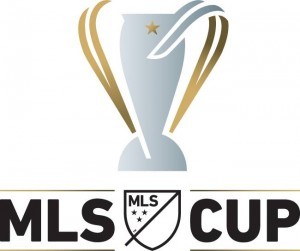 Anyone who’s a regular reader of this website, a subscriber to Plastic Pitch or has heard my commentary on FC Edmonton broadcasts knows that I’m usually pretty forgiving when it comes to match officials. We’re so often quick to judge referees who have to make split-second decisions when we, as spectators and pundits, have the luxuries of super slo-mo replays and reverse angles.
Anyone who’s a regular reader of this website, a subscriber to Plastic Pitch or has heard my commentary on FC Edmonton broadcasts knows that I’m usually pretty forgiving when it comes to match officials. We’re so often quick to judge referees who have to make split-second decisions when we, as spectators and pundits, have the luxuries of super slo-mo replays and reverse angles.
But, on Sunday, referee Jair Marrufo and his crew had a stinker of a game that simply can’t be overlooked. Portland’s 2-1 triumph over Columbus in MLS Cup will likely be held up as the new standard for everybody who believes the quality of officiating in North America simply isn’t good enough.
The only reason that key errors made by Marrufo and his linesmen won’t overshadow the game is the fact that the better team won. Portland was by far the superior team on the field. You don’t deserve style points for hitting goalpost after goalpost, but they were signs of just how much the Timbers bossed this tilted-field affair. The Timbers dominated every offensive category, from chances created to shots on goal.
Still, it needs to be noted that Portland’s second goal was the result of a critical error by the linesmen. Near midfield, the ball clearly rolled out of the field of play and into touch — by a good margin. You could see a large swath of green grass in between the line and the ball. Yet, play wasn’t stopped. The Crew players — most notably Tony Tchani, who was the closest to the play — stopped. Timber Lucas Melano sprinted down the field, crossed the ball to Rodney Wallace, and Portland had its second goal, the one that would provide the men in green their margin of victory.
Now, the Crew was definitely guilty of not doing what every five-year-old players is told to do: Playing to the whistle. But, wow, that ball was into touch by a significant margin, and professional players expect to see that throw-in awarded 100 times out of 100.
But, before crying foul about the mistake that led to the Timbers’ second goal, let’s fast forward to the second half and a mistake that went in the Crew’s favour. The Timbers were hitting posts with regularity. In a goalmouth scramble, the ball came down off the underside off the crossbar and struck Columbus defender Michael Parkhurt’s arm on the goal line. Parkhurst’s arm was moving, so there was no ball-to-hand defence. It was a stone cold penalty — and red card. Yet, it was totally missed by Marrufo — and if he didn’t see it, you have to question how a referee at the level of calling a championship game, a guy named the best official in the league, is out of position when the ball is rattling around in the penalty area.
If Marrufo is indeed the best the league has, the best that the Professional Referee Organization has, the performance by him and his linesmen in MLS Cup is cause for greater concern.
SUPPORT OUR DRIVE FOR 500! SUPPORT CANADIAN SOCCER JOURNALISM! SUBSCRIBE TO PLASTIC PITCH TODAY!
December 3, 2015
Fordyce had other NASL offers, but says he wanted to remain loyal to FC Edmonton

Daryl Fordyce
In the three years he’d spent with FC Edmonton, Daryl Fordyce became the club’s all-time leading scorer.
And, while he did have offers from other NASL clubs after his contract expired at the end of the 2015 season, he decided that he wanted to add to his record tally rather than switch shirts.
“There was some interest out there for me,” Fordyce said Thursday over the phone from Belfast. “There was interest from other NASL teams and elsewhere.”
But the reason he decided to re-sign with the Eddies — which he did earlier in the week — was simple. Loyalty. He felt that the club and coach Colin Miller had helped his career, and he didn’t feel it was right to walk away from Edmonton if the Eddies wanted him back.
“I’ve been with the team for three years. And, through my career I have remained loyal to the people who have been good to me. Colin and FC Edmonton have been good to me, and I want to make the playoffs with FC Edmonton. We haven’t done that in the time I’ve been here, and that’s one of my ambitions.
“I really enjoy training. I enjoy coming to work. And that’s something you have to look at, if you enjoy going to work every day, is it worth taking the chance to go somewhere else.”
So, as for the goal of the playoffs, Fordyce identified a couple of key areas where the club needs to improve. In the past two seasons, the club has endured poor spring seasons, leaving a lot of ground to make up in the overall standings. And, he noted that while the Eddies fared pretty well against the likes of Minnesota, New York and Tampa Bay, they struggled against teams at the bottom of the table.
“We didn’t have a good start to the season, and we were hurt by a few injuries and some of the international call-ups came at a bad time. But, Jacksonville finished at the bottom of the table — and we didn’t beat them this year. When I played in Northern Ireland, the ‘big four’ teams knew that when they played the teams at the bottom, that was where the league was won. If you played in a top-of-the-table match one week, then had to play someone at the bottom the next week, you knew that you’d have to give 110 per cent or else you could lose your place.”
SUPPORT OUR DRIVE FOR 500! SUPPORT CANADIAN SOCCER JOURNALISM! SUBSCRIBE TO PLASTIC PITCH TODAY!

